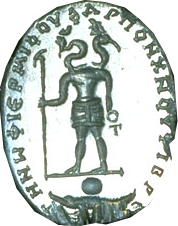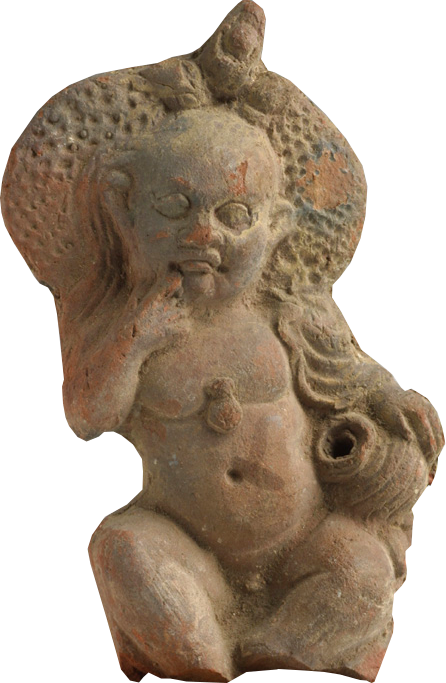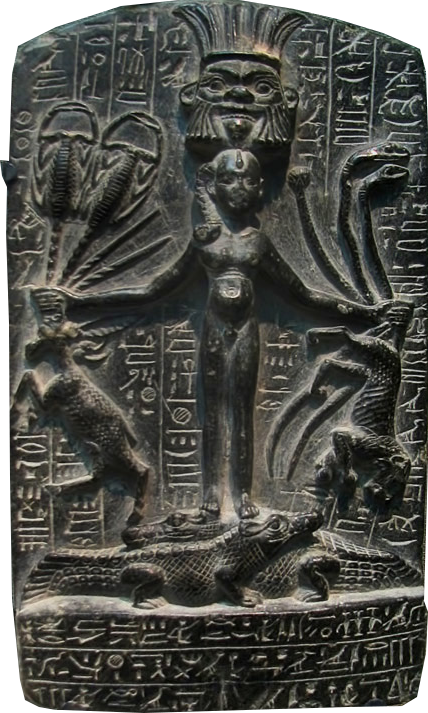Ancient Psychedelia: Alien Gods & Mushroom Goddesses
Online Book - Chapter 10, Page 167
Back to Online Book Mainpage / Next Page (Chapter 10, Page 168)
| It is suggested the Jackal-headed god Anubis is related to Hermes as Messenger, psychopomp, or guide of souls to the land of the dead. Residing in the Gregorian Egyptian Museum is a statue of the god Hermanubis, a jackal-headed god, carrying a caduceus staff. Porphyry refers to Hermanubis as a “composite,” and “half-Greek.” (82) Amin Benaissa, in a paper entitled, The Onomastic Evidence for the God Hermanubis, states: “It is clear that the name (Hermanubis) is a result of the assimilation of the Egyptian god Anubis to the Greek god Hermes, which is well attested in a number of literary, epigraphic, and artistic sources.” (83) Graves, in the White Goddess, brings the reader’s attention to a relatively unknown Egyptian gem that was found depicting Anubis with palm and pouch on the obverse, and on the reverse, an archangel named Gabrier Sabao, which means Gabriel Sabaoth. This is the origin of our Archangel Gabriel in modern Christianity. Therefore Hermes = Thoth = Anubis = Gabriel. (84) Amulet depictions of Thoth have him serpent headed, appearing as Abraxas (39e).  (39e) Intaglio, Abraxas Variation c. 100-600 AD Horus or Ra was the “Bull of Heaven” (85) and impregnated the queen called “the cow who bore the bull,” as Ra impregnated the body of Nut “with the seed of the spirit that must be in her.” (86) Horus is mentioned in association with the acacia plant in a text from the Brugsch Papyrus which reads: “I am Horus, who spendeth the day in Abydos; my staff doth afford protection. – Praise be unto thee, thou proper staff that dost protect the limbs, thou wand of the sacred acacia.” (87) During the time of the Second Dynasty RA became a central focus of the worship of Egypt and by the Fifth Dynasty he became one of the most important deities in the Egyptian pantheon. Ra ruled the sky, the earth and the underworld and his associated animal was the falcon whose head he was always portrayed wearing. In Sanskrit Ra means “royal” or exalted on high. Both the Sanskrit words for king, “raja” and queen “rani” both contain the prefix of Ra. In French, the word roi means king and in English we get our “royal,” “regal” and “reign” from this same prefix. (88) |
In later Egyptian dynasties, Ra was merged with Horus, and eventually during the New Kingdom (16th century BC - 11th century BC) when Amen rose in prominence he was merged into Amun-Ra and then Ra was completely suppressed by Akhenaten in favor of the god Aten. Ra was also associated with the Mnevis bull, essentially the husband of Hathor whose center of worship was Heliopolis. It was held mythically, at least, that all creation stems from the tears and sweat of Ra, and therefore Egyptians considered themselves the “Cattle of Ra.” The Egyptian text called the “Book of the Cow of Heaven” describes RA and humanity’s rebellion against him. (This may have been the prototype for the idea of lucifer’s rebellion, though it likely went back even further to Babylon.) The “Eye of Ra” is where the Illuminati took their concept of design. The Eye of Ra implies the third eye and is shaped similar to the pineal gland. The pineal gland is considered by Descartes to be the center of the third eye, the seat of inner wisdom. The mushroom, DMT, and all psychedelics, stimulate this center to induce psychic visions. Horus is portrayed in a Graeco-Roman / Egyptian figurine c. 300 - 30 BC, where he is seated with some sort of a round spotted veil around his head, likely the A. muscaria itself (33b). In some odd depictions Horus the Younger is holding scorpions, whose heads are composed of obvious mushrooms, though well occulted in art (33c).   R: (33c) Horus the Younger (82) De imaginibus fr. 8, p. 18.1–2 Bidez (83) https://quod.lib.umich.edu/cgi/p/pod/dod-idx/onomastic-evidence-for-the-god-hermanubis.pdf?c=icp;idno=7523866.0025.116;format=pdf (84) The White Goddess, p. 151 (85) Pyramid Text 282c (86) Pyramid Text 990d (87) Healing Gods, p. 46 (88) When God was a Woman, p. 90 |
Go Back to Page 166